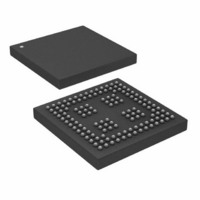ADSP-21261SKBCZ150 Analog Devices Inc, ADSP-21261SKBCZ150 Datasheet - Page 9

ADSP-21261SKBCZ150
Manufacturer Part Number
ADSP-21261SKBCZ150
Description
150 MHz, 32Bit DSP Processor
Manufacturer
Analog Devices Inc
Series
SHARC®r
Type
Fixed/Floating Pointr
Specifications of ADSP-21261SKBCZ150
Interface
DAI, SPI
Clock Rate
150MHz
Non-volatile Memory
ROM (384 kB)
On-chip Ram
128kB
Voltage - I/o
3.30V
Voltage - Core
1.20V
Operating Temperature
0°C ~ 70°C
Mounting Type
Surface Mount
Package / Case
136-CSPBGA
Device Core Size
32/40Bit
Architecture
Super Harvard
Format
Floating Point
Clock Freq (max)
150MHz
Mips
150
Device Input Clock Speed
150MHz
Ram Size
128KB
Program Memory Size
384KB
Operating Supply Voltage (typ)
1.2/3.3V
Operating Supply Voltage (min)
1.14/3.13V
Operating Supply Voltage (max)
1.26/3.47V
Operating Temp Range
0C to 70C
Operating Temperature Classification
Commercial
Mounting
Surface Mount
Pin Count
136
Package Type
CSPBGA
Lead Free Status / RoHS Status
Lead free / RoHS Compliant
Lead Free Status / RoHS Status
Lead free / RoHS Compliant
Available stocks
Company
Part Number
Manufacturer
Quantity
Price
Company:
Part Number:
ADSP-21261SKBCZ150
Manufacturer:
Analog Devices Inc
Quantity:
10 000
Part Number:
ADSP-21261SKBCZ150
Manufacturer:
ADI/亚德诺
Quantity:
20 000
complexity, this capability can have increasing significance on
the designer’s development schedule, increasing productivity.
Statistical profiling enables the programmer to nonintrusively
poll the processor as it is running the program. This feature,
unique to VisualDSP++, enables the software developer to pas-
sively gather important code execution metrics without
interrupting the real-time characteristics of the program. Essen-
tially, the developer can identify bottlenecks in software quickly
and efficiently. By using the profiler, the programmer can focus
on those areas in the program that impact performance and take
corrective action.
Debugging both C/C++ and assembly programs with the
VisualDSP++ debugger, programmers can:
The VisualDSP++ IDDE lets programmers define and manage
DSP software development. Its dialog boxes and property pages
let programmers configure and manage all of the SHARC devel-
opment tools, including the color syntax highlighting in the
VisualDSP++ editor. This capability permits programmers to:
The VisualDSP++ Kernel (VDK) incorporates scheduling and
resource management tailored specifically to address the mem-
ory and timing constraints of DSP programming. These
capabilities enable engineers to develop code more effectively,
eliminating the need to start from the very beginning when
developing new application code. The VDK features include
threads, critical and unscheduled regions, semaphores, events,
and device flags. The VDK also supports priority-based, pre-
emptive, cooperative, and time-sliced scheduling approaches. In
addition, the VDK was designed to be scalable. If the application
does not use a specific feature, the support code for that feature
is excluded from the target system.
Because the VDK is a library, a developer can decide whether to
use it or not. The VDK is integrated into the VisualDSP++
development environment, but can also be used via standard
command line tools. When the VDK is used, the development
environment assists the developer with many error-prone tasks
and assists in managing system resources, automating the gen-
eration of various VDK-based objects, and visualizing the
system state, when debugging an application that uses the VDK.
• View mixed C/C++ and assembly code (interleaved source
• Insert breakpoints
• Set conditional breakpoints on registers, memory,
• Trace instruction execution
• Perform linear or statistical profiling of program execution
• Fill, dump, and graphically plot the contents of memory
• Perform source level debugging
• Create custom debugger windows
• Control how the development tools process inputs and
• Maintain a one-to-one correspondence with the tools’
and object information)
and stacks
generate outputs
command line switches
Rev. 0 | Page 9 of 44 | March 2006
VisualDSP++ Component Software Engineering (VCSE) is
Analog Devices’ technology for creating, using, and reusing
software components (independent modules of substantial
functionality) to quickly and reliably assemble software applica-
tions. It also is used for downloading components from the
Web, dropping them into the application, and publishing com-
ponent archives from within VisualDSP++. VCSE supports
component implementation in C/C++ or assembly language.
Use the expert linker to visually manipulate the placement of
code and data on the embedded system. View memory utiliza-
tion in a color-coded graphical form, easily move code and data
to different areas of the DSP or external memory with a drag of
the mouse, and examine runtime stack and heap usage. The
expert linker is fully compatible with existing linker definition
file (LDF), allowing the developer to move between the graphi-
cal and textual environments.
In addition to the software and hardware development tools
available from Analog Devices, third parties provide a wide
range of tools supporting the SHARC processor family. Hard-
ware tools include SHARC processor PC plug-in cards. Third-
party software tools include DSP libraries, real-time operating
systems, and block diagram design tools.
ADSP-21261













